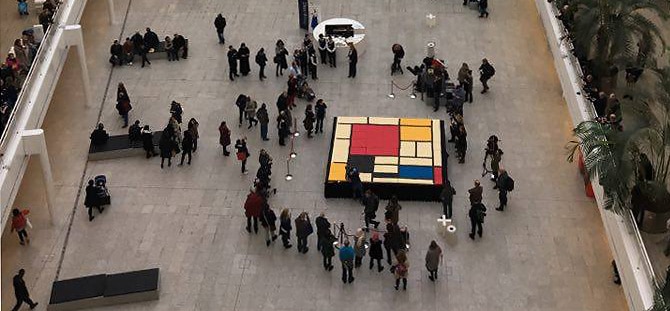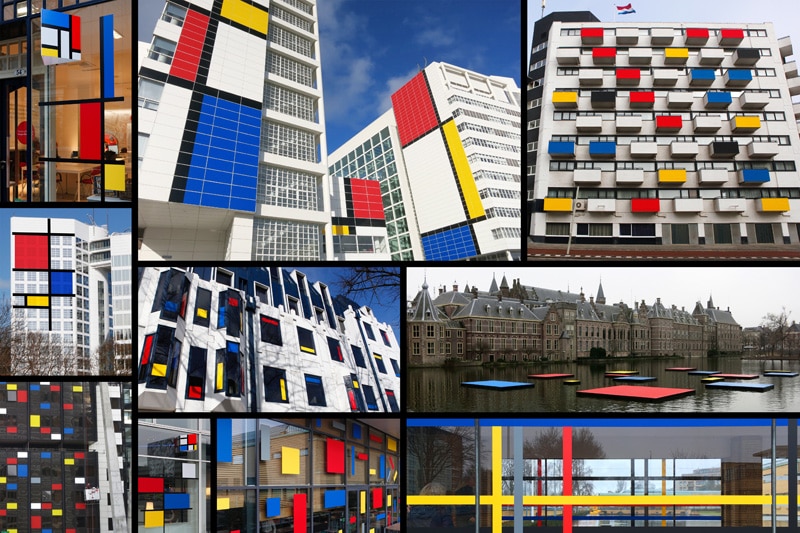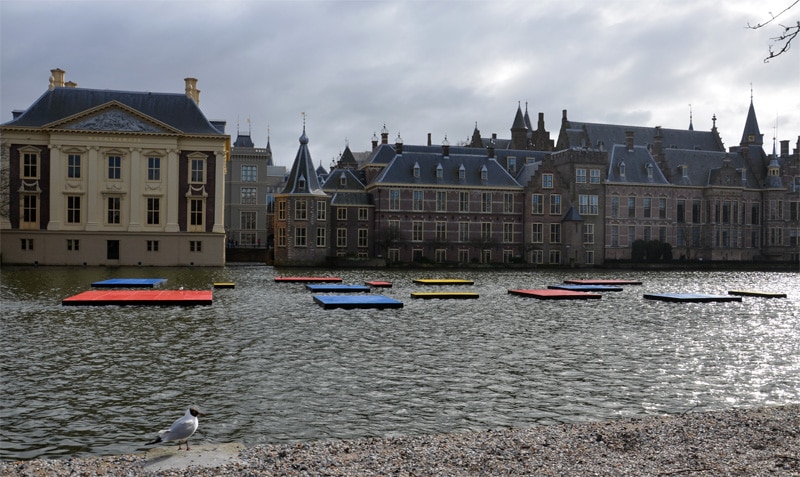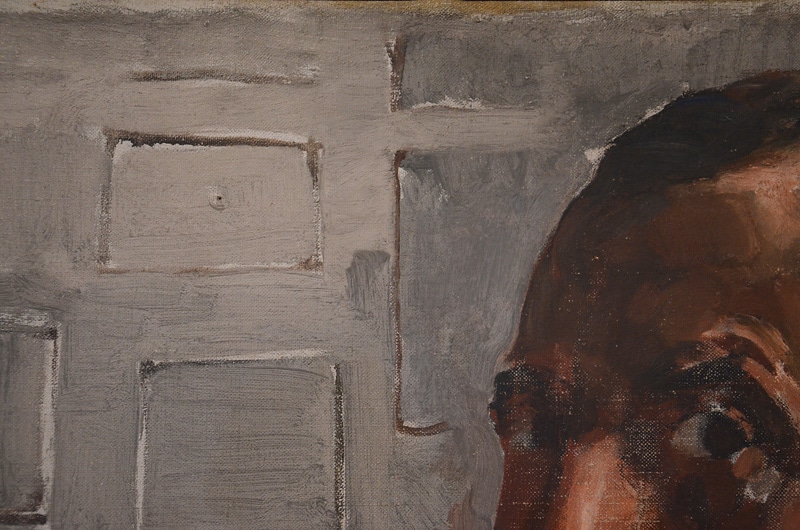Op de verjaardag van Piet Mondriaan, 7 maart, bood de gemeente Den Haag haar inwoners een kolossale gedecoreerde taart aan. Het past in een zeer actieve campagne rondom 100 jaar De Stijl. Terwijl het Gemeentemuseum dit jaar drie inhoudelijke Stijl-tentoonstellingen presenteert, gaat Den Haag helemaal los met Stijl-imitaties en beplakte winkelruiten. Een tegenstelling? Minder dan het lijkt, want deze citydressing gebeurt onder auspiciën van het museum.

Neem de campagnekreet “Den Haag kleurt Mondriaan” maar letterlijk. Van de muur van het stadhuis tot vlonders in de Hofvijver, van bioscoopramen tot hotelbalkons en niet te vergeten talloze winkels in de binnenstad – de kleurvlakken en lijnen zijn werkelijk overal. Hoe zit dat? Er waren geen belangrijke Stijl-kunstenaars gevestigd in Den Haag en Theo van Doesburg was meer de centrale figuur in De Stijl dan Mondriaan. Vanwaar dan toch die enorme Mondriaancampagne?
Vieren
Mijn eerste vraagbaak is het Gemeentemuseum. Woordvoerder Anne de Haij laat weten dat het museum zich niet alleen op Mondriaan richt. Met de drie tentoonstellingen naast de vaste De Stijl-opstelling ‘vieren we de verjaardag en de grootsheid van De Stijl als beweging en toonaangevende bijdrage aan de internationale kunst. En van één van de Stijl-kunstenaars die na De Stijl ook uitgroeide tot ’s werelds beroemdste moderne kunstenaar, Piet Mondriaan.’
Volgens De Haij is de Haagse campagne ingezet door de gemeente en Den Haag Marketing. ‘Waarschijnlijk vanuit de gedachte dat Den Haag met ’s werelds grootste collectie Mondriaans de “internationale thuishaven” is van Piet.’
Op naar Den Haag Marketing dus. Daar vertelt Mieke Smid: ‘Met het themajaar vieren we dit jubileum, viéren we Mondriaan. De evenementen, tentoonstellingen, merchandise, routes, menu’s, lezingen, hotelkamers, citydressing en toolkits voor het MKB moeten zorgen voor herkenbaarheid, moeten het gevoel van vieren oproepen. Dit kleuren- en lijnenspel is herkenbaar en doet precies dat! Dit alles bij elkaar zorgt voor een reden om juist nu naar Den Haag te komen, de stad te ervaren, er te verblijven en mee te vieren.’
Citydresser
Via Den Haag Marketing kom ik in contact met Matthijs de Groot, door de gemeente ingehuurd als kwartiermaker voor de campagne. Hij werkt samen met citydresser Madje Vollaers van Studio Vollaerszwart. Dit bedrijf versierde eerder onder andere de Erasmusbrug in Rotterdam.

De Groot interesseert partners in de stad om mee te doen aan de Mondriaancampagne. ‘We kijken naar plaatsen die high traffic zijn en strategisch goed liggen. Er moeten veel mensen langskomen en ze moeten goed zichtbaar zijn.’ Vervolgens maakt Vollaerszwart een ontwerp.
Maar hoe veel hebben de rood-geel-blauwe creaties werkelijk met Mondriaan of De Stijl te maken? Vollaers: ‘We maken geen bestaande kunstwerken na, maar zijn geïnspireerd door De Stijl. Eigenlijk werken we zelf als een soort Stijlkunstenaars: we kijken naar een gebouw en maken er een Stijlkunstwerk van op de manier van Van der Leck of Van Doesburg. De link van De Stijl met architectuur is natuurlijk eenvoudig.’
Folies en lijmen
Vollaers maakt voor elk gebouw een uniek ontwerp, maar is daarin niet geheel vrij. ‘Het Gemeentemuseum doet een esthetische toetsing. Ik maak een plan voor een gebouw en vraag goedkeuring aan het museum.’
Als het ontwerp akkoord is – en tot nog toe zijn alle ontwerpen goedgekeurd – gaat Vollaers aan de slag met plakfolies en speciale lijmen. Alles moet er na afloop namelijk weer af kunnen. De kosten zijn voor een groot deel voor de eigenaars van het te versieren gebouw.

Een bijzonder verhaal zit achter de vlonders in de Hofvijver. Vollaers: ‘Mondriaan had veertien rode, gele en blauwe doeken in zijn atelier liggen en begon iedere dag met het maken van een nieuwe compositie daarvan.’
‘Dat kan mijn kleinkind ook’
Naast de “grote” citydressing is er de gratis toolkit voor winkeliers. Met een “makelaarsbord”, zwarte tape en een lapje folie van elk van de drie Stijlkleuren mogen zij zelf aan de slag en doen ze mee in een competitie om de mooiste Mondriaanetalage. Dat levert aardige composities op, maar ook aandoenlijke probeersels en regelrechte horreurs.
De Groot: ‘Haha, je zou het aan de winkeliers moeten vragen, die vinden het vaak ook tegenvallen hoe makkelijk het is om echt iets moois te maken. Daarbij is een Mondriaan-etalage inderdaad wel iets ander dan een echte Mondriaan.’

Atelier in Laren
Bij de overdaad aan Stijlkleuren en daarin omgaande financiering steekt de werkelijkheid van honderd jaar geleden schril af. Op de zeer gedegen en mooi vormgegeven tentoonstelling in het Gemeentemuseum zien we dat Piet Mondriaan rond 1916-18 zijn atelier had in een armelijke hut in Laren, omdat hij door de Eerste Wereldoorlog niet terug kon naar zijn woonplaats Parijs.
Hij ontmoette Bart van der Leck in het huis van mevrouw Kröller-Müller en – warempel – dat stond in Den Haag, aan het Lange Voorhout. Van der Leck was bezig met primaire kleuren, Mondriaan werkte steeds abstracter. Zo inspireerden de heren elkaar zonder speciaal vrienden te zijn. En dat allemaal ruim voor uiteindelijk in 1917 het tijdschrift De Stijl het licht zag.
De tentoonstelling geeft een breed beeld van deze periode en dat beeld ziet er heel anders uit dan de versierde gebouwen buiten. “Primaire kleuren” konden bij Mondriaan in deze periode bijvoorbeeld ook nog donkerroze, oker en grijsblauw zijn. En Van der Leck verliet zelfs nooit helemaal het figuratieve. In een doek vol vlakjes zijn meestal nog de contouren te herkennen van een hondenkar of een vrouwenportret.

Kleurvlakjes op de wand
In een video-installatie is de hut in Laren te zien, die er nog altijd is. Met kartonnetjes op de wand is daar een groep kleurvlakjes gereconstrueerd, die Mondriaan er ooit op de wand schilderde. Dat de vlakjes daar gezeten hebben, is pas recent ontdekt op het zelfportret uit 1918, waarvan u hier een detail ziet. Op de achtergrond geen schilderij, zoals lang werd gedacht, maar de kleurvlakjes in de hut. Het klopt precies – inclusief een punaisegaatje. Alles in een – mag ik het zeggen? – weldadig kalm grijs.

- De tentoonstelling Piet Mondriaan en Van der Leck – de uitvinding van een nieuwe kunst is te zien in het Gemeentemuseum Den Haag tot en met 21 mei 2017.
- De Haagse campagne is onderdeel van het landelijke Mondriaan to Dutch Design van het Nederlands Bureau voor Toerisme & Congressen.
- Meer steden venten het Stijl-jaar uit; zo prijkt onder het motto #utrechtheeftstijl een reuze-Rietveldstoel op het Domplein.
